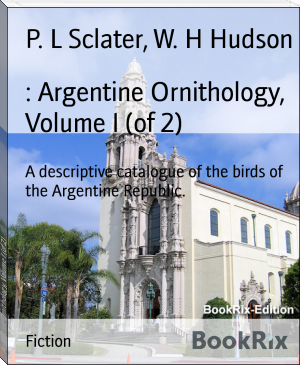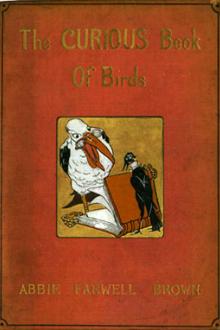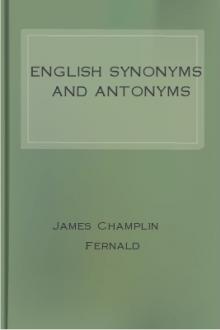: Argentine Ornithology, Volume I (of 2), P. L Sclater, W. H Hudson [best authors to read txt] 📗

- Author: P. L Sclater, W. H Hudson
Book online «: Argentine Ornithology, Volume I (of 2), P. L Sclater, W. H Hudson [best authors to read txt] 📗». Author P. L Sclater, W. H Hudson
blacker than its plumage; and, to enhance the effect, the beak is of a
very delicate primrose-yellow, which at a little distance appears white,
hence the vernacular name. The eye, and broad free skin surrounding
it, which is ruffed like an Elizabethan collar, are of the same faint
primrose hue. The secondary wing-quills are pure white, but the white
is only displayed when the bird flies. The female has the naked skin
encircling the eye, but its colour, as also that of the beak, is much
darker than in the male. Entire upper plumage dark brown; secondaries
chestnut; lower parts fawn-colour, marked with brown. The young males
are at first like the females in colour, and do not acquire the black
plumage until the end of the summer.
The bird ranges over the whole of the Argentine Republic, and, according
to Gay, is also common throughout Chili, where it is known as the
_Colegial_ (Collegian or learned person), on account of its stiff grave
manner, black dress, and spectacled appearance.
The male is a solitary bird, and feeds chiefly on the ground, running
rapidly about in open places like a _Muscisaxicola_. It is also
frequently seen perched conspicuously on the summit of a tall stalk or
bush, and occasionally making a dart into the air after passing insects,
showing in this habit his relationship with the Tyrant-birds. But he
perches on an elevation less to watch for insects than for the purpose
of his curious spectacular performance. This highly eccentric habit is
strikingly like that of _Cnipolegus hudsoni_; and I have no doubt that
all the _Cnipolegi_ possess similar habits. Both birds perch on a
conspicuous place, upright, motionless, and looking more like grotesque
little automata than living things; they both also leave the perch
suddenly, as if shot from it by means of a steel spring. This singularly
sudden movement, and the motion of the wings, rapid as in the
Humming-bird, or shut and opened alternately and exhibiting the white
wing-colour in a series of flashes, seems related to the conspicuous
white mark. In both species, also, the wings make a humming sound during
flight. The motions of the Silver-bill are, however, in some respects
different from those of the _Cnipolegus_. Springing from its perch at
intervals, it darts vertically to a height of about fifteen yards, then
turns a summersault, uttering at the same moment a shrill-sounding
little cry, after which it drops down again and alights on its perch
suddenly, as if jerked back to it, and there remains stiff, erect, and
motionless as before.
The nest is made of dry grass in a thistle-bush or clump of reeds, and
is rather deep and cup-shaped. The eggs are four in number, white, and
spotted at the larger end with dark red.
132. MACHETORNIS RIXOSA (Vieill.). (SHORT-WINGED TYRANT.)
+Machetornis rixosa+, _Burm. La-Plata Reise_, ii. p. 458 (Paraná);
_Scl. et Salv. P. Z. S._ 1868, p. 142; _iid. Nomencl._ p. 44;
_Hudson, P. Z. S._ 1874, p. 173 (Buenos Ayres); _Durnford, Ibis_,
1877, p. 177 (Buenos Ayres); _Salvin, Ibis_, 1880, p. 357
(Salta); _Barrows, Bull. Nutt. Orn. Cl._ viii. p. 142
(Entrerios).
_Description._--Above brownish olive; wings and tail brown, the
latter terminated by a yellowish band; middle of cap occupied by a
scarlet crest; beneath bright yellow, paler on the throat; bill and
feet black: whole length 7·2 inches, wing 3·9, tail 3·5. _Female_
similar, but rather duller. Young without the scarlet crest.
_Hab._ S.E. Brazil, Bolivia, Paraguay, Uruguay, and La Plata.
This species, found in the open districts throughout South America,
from Venezuela to Buenos Ayres, where it is quite common, has very
interesting habits. It is seven inches and a half long, has a plump
body, short wings, and long legs. The upper plumage is light brown, the
throat, breast, and belly yellow, and the male has a concealed crest of
a bright orange-red colour.
It resembles the true Tyrants in disposition, in its shrill piercing
language, and in the habit of perching and breeding in trees. On the
other hand, like the long-legged _Myiotheretes_, that lives on the open
plains, it feeds exclusively on the ground, over which it runs with a
speed possessed by few perching species. The general impression one
forms is that in manners and appearance the Short-winged Tyrant is quite
unlike any other species, though all its habits are to be found in one
or other of the various groups comprising the _Tyrannidæ_.
These birds have no migration, but pair for life, and always remain on
the same spot, and will continue to breed in the same hole for many
years, even where they are frequently deprived of their eggs. Azara saw
them sometimes uniting in small flocks in Paraguay; in Buenos Ayres they
are always seen in pairs, or, after the young have left the nest, in
families. They prefer to live near a human habitation, where there are
trees: even one tree, in which they can breed and find shelter at night,
will be sufficient to attach them to a dwelling, so great is their
partiality for the clean-trodden ground where they can freely run about
and catch insects. They haunt the cattle-pens, and become extremely
familiar with the cows, horses, and sheep, following them to the
pasture-grounds, where they are often seen perched on the back of a
horse or other domestic animal, or stationed close to its nose on the
ground, watching for insects. On the bare ground they run about with
wonderful swiftness, and are able to overtake and capture flying insects
without rising. The male and female invariably hunt together, and at
intervals fly to some favourite perch to indulge in a duet composed of
loud, rapid, shrill notes, somewhat metallic in sound. Though able to
fly swiftly when in pursuit of a passing hawk or other bird, at other
times their flight is strangely slow; the round body, short blunt wings
and tail giving the bird a somewhat curious appearance as it progresses
laboriously through the air. I have frequently seen them make the most
unprovoked assaults on birds of an inoffensive kind; possibly they are
in these attacks moved by a playful rather than by a vindictive spirit.
I once saw one drop like a stone from a height of fifty yards on to a
Pigeon perched on a leafless tree. The Pigeon fell as if shot to the
earth; the Tyrant-bird then released his hold; the Pigeon rushed away
terrified through the trees, while its persecutor rose high up in the
air and resumed its journey.
I have elsewhere spoken of the wars waged by this bird against other
species, all seeking to gain possession of the large nest of _Anumbius
acuticaudatus_. A hole in the trunk of a tree is also a favourite
breeding-place. The nest is neatly built of slender twigs and leaves,
and lined with horse-hair. The eggs are slightly oval, and densely
marked with dark brown spots or stripes on a white or brownish-white
ground.
133. MUSCISAXICOLA MACLOVIANA (Garn.). (CHIN-SPOTTED TYRANT.)+Muscisaxicola mentalis+, _Hudson, P. Z. S._ 1872, p. 541 (Rio
Negro); _Scl. et Salv. Nomencl._ p. 44.
_Description._--Above cinereous, lores blackish, cap brown;
tail-coverts and tail black, outer margins of outer tail-feather
white; below pale cinereous, passing into white on lower belly,
crissum, and under wing-coverts; chin-spot brown: bill and feet
black: whole length 6·1 inches, wing 4·1, tail 2·6. _Female_
similar, but chin-spot not so well marked.
_Hab._ Peru, Bolivia, Chili, Patagonia, and Falkland Islands.
This South-Patagonian species is one of a Chilian group of Tyrant-birds
which resemble in their habits the _Saxicolæ_ of Europe. The plumage is
generally grey, with more or less rufous colour on the crown; they have
long legs, and run swiftly on the ground, frequent open sterile
situations, and perch only occasionally on trees.
The present bird is about seven inches long; the upper parts are dull
grey, except the crown, which is dark chestnut; under surface light
grey, and tail nearly black. In the month of June I met with these birds
on the Rio Negro, on their arrival there from the south. They went in
flocks of a dozen or twenty birds; they had a swift easy flight, were
shy and restless in their manner, and uttered low plaintive whistling
notes. When a flock alights on the ground the birds all instantly
scatter, running rapidly about in all directions over the bare ground.
Occasionally one was seen to perch on some slight elevation, and dart
like a Flycatcher after passing insects.
Darwin saw this bird as far north on the Atlantic coast as Bahia Blanca.
He also found it at Tierra del Fuego, where it lives entirely on the
sea-beaches; and in the sterile upper valleys of the Chilian Andes, at a
height of ten thousand feet, where the last traces of vegetation occur
and where no other bird lives.
134. MUSCISAXICOLA RUFIVERTEX, d'Orb. et Lafr. (RED-TOPPED TYRANT.)+Ptyonura rufivertex+, _Burm. La-Plata Reise_, ii. p. 461 (Mendoza).
_Description._--Above clear cinereous; lores and short
superciliaries whitish; well-defined nape-patch bright rufous; wings
brownish; upper tail-coverts and tail black, outer margin of outer
rectrix white: below clear cinereous white, brighter on lower belly,
crissum, and under wing-coverts; bill and feet black: whole length
6·5 inches, wing 4·0, tail 2·8. _Female_ similar.
_Hab._ Peru, Bolivia, Chili, and Western Argentina.
135. MUSCISAXICOLA MACULIROSTRIS, d'Orb. et Lafr. (SPOT-BILLED TYRANT.)
+Muscisaxicola maculirostris+, _Scl. et Salv. Nomencl._ p. 44;
_Durnford, Ibis_, 1878, p. 395 (Centr. Patagonia). +Ptyonura
maculirostris+, _Burm. La-Plata Reise_, ii. p. 462 (Mendoza).
_Description._--Above greyish brown, lores and slight superciliaries
whitish; tail-coverts and tail black, the outer web of the outer
rectrix white; below pale greyish white,





Comments (0)